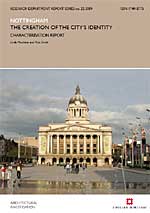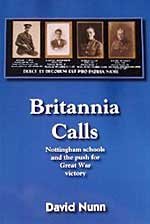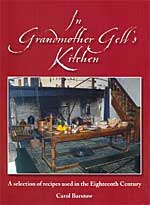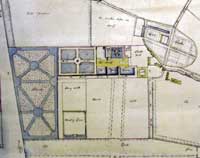Book reviews, Summer 2010
NOTTINGHAM THE CREATION OF THE CITY'S IDENTITY CHARACTERISATION REPORT (English Heritage Research Department Report Series no. 22.2009 ISBN 1749-8775)

This publication is an A4 soft-back book of 96 pages, profusely illustrated with colour photographs and is co-authored by Linda Monkton and Thoroton Council member, Pete Smith. It was commissioned by English Heritage's East Midlands Regional Team to assist them with their regular casework within the City of Nottingham. The book opens with a brief history of the City followed by chapters considering the City Centre, Industrial Strip, Inner Suburbs and the Outer Suburbs. Each chapter consists of an overview of that particular part of the City, augmented by useful plans and photographs. Major buildings and developments are considered and placed into the historical and contemporary context. The authors have not been afraid of being critical where they consider it justified but this is balanced by praise for certain developments. Of necessity the book cannot be an in-depth survey of all the developments and buildings in the City but it represents a significant and very useful contextural review of the City as it was in 2009 against which new proposals for developments can be assessed. The book is available from the English Heritage Research Department, best accessed from the internet at research.english-heritage.org.uk/report/?14738. It is written in a clear, easily read style that will be enjoyed by the general reader as well as the professional dealing with planning and development matters. Howard Fisher
BRITANNIA CALLS: NOTTINGHAM SCHOOLS AND THE PUSH FOR GREAT WAR VICTORY (Knowle Hill Publishing, 2010 ISBN 978-0-9566045-0-0)

Not everyone celebrated the Armistice on 11 November 1918. More than 5,000 men, many of them hardly out of boyhood, had died in the conflict, and for their families, from Bulwell, to Sneinton and to St. Anne's (in particular) this was less a celebration than it was a wake. Had their son(s) died for a great cause, or to satisfy the vanity of European leaders who deployed them as pawns in a game of power politics? There are no survivors of the conflict left now, either combatants or first generation family, and this is perhaps the time to reconsider just what the war was all about. David Nunn, who has lived in Nottingham most of his life, and taught at various schools until he retired in 2005, has looked at a number of themes in this interesting and well written book, including the impact of the war on education, on teachers who were called up (and their female replacements in the classrooms), and (if only in passing) on life on the 'home front', the daily grind of living in Nottingham. Perhaps most interesting, in what he calls a pre-counselling society, was the need to keep a stiff upper lip, even as the telegrams telling of death in warfare were arriving. There is more to be done on Nottingham at War, and this is clearly the time to begin, with 2014 only just around the corner. David's next task is to look in more detail at how the war to end all wars, with its high priorities and grand ideals, actually impacted on the people of Nottingham.
John Beckett
IN GRANDMOTHER GELL'S KITCHEN. A selection of recipes used in the Eighteenth Century by Carol Barstow (Nottinghamshire County Council, 2009: ISBN 978-0-902751-63-7)

This 72 page book is based on the author's research for the MA in Local and Regional History. Carol's dissertation, and this book, looked at kitchens and cooking 1650-1800 and during her research she came across a collection of manuscripts described as 'The Receipt Book of Grandmother Gell', hence the title of the book. Carole traces the Gell family who were from Wirksworth and describes the family home of Hopton Hall from an inventory of 1738/9. The difficulties in dating the recipes is described as well as Carol's efforts in converting them to modern use and she includes a selection of the recipes in the last section of the book. Descriptions of the meals eaten by the family are included with the actual menus used and there is an amusing section regarding the expected table manners. Roles of C18th housewives are described which include Gervase Markham's comments about the personal qualities of a housewife. One wonders if there was a Mrs. Markham and whether she lived up to his expectations. This is an enjoyable and well researched book and of interest to the modern historian of the family and eating habits. Others might wish to try some of the recipes but whether the reader will wish to sample the cures described is questionable. The book costs £5.95 and can be obtained from the Nottinghamshire Archives, major libraries in the County or by post (£3.00 p&p from Libraries Archives & Information, Nottinghamshire County Council, 4th Floor, County Hall, West Bridgford, NG2 7QP.
www.nottinghamshire.gov.uk/home/leisure/libraries/libraries-publications.htm
Jackie Fisher
ENGLISH HERITAGE HISTORICAL REVIEW VOLUME 4, 2009

English Heritage's annual academic journal includes an article entitled Rufford Abbey and its Gardens in the 17th and 18th Centuries written by Pete Smith and which may be of interest to Thoroton members. Pete has utilised a series of drawings which form part of the Savile Papers deposited in the Nottinghamshire Archives, along with both modern and historic photographs, to elucidate for the first time the likely development of both the house and the previously unknown formal gardens which were laid out at Rufford Abbey in the late 17th century.
Copies of the article as a pdf can be obtained from Pete Smith at b.baptist@ntlworld.com.
Copies of the journal have been lodged with the Nottingham Local Studies Library and the Nottinghamshire Archives.
The journal costs £20.00 plus postage and packing and is available from: English Heritage Mail Order Services, Gillards Worldwide, Trident Works, Temple Cloud, Bristol, BS39 5AZ. Email: ehsales@gillards.com